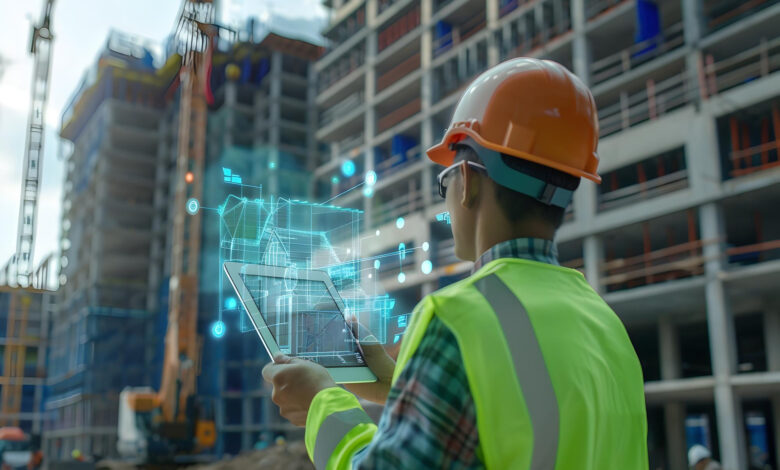
Introduction
Large-scale construction projects involve coordinating dozens of stakeholders, revenue streams, public-private interests, and trade negotiations before ever putting a shovel in the ground. Against a backdrop of economic uncertainty, ESG considerations, and layers of code requirements and zoning rules, the stakes to deliver are invariably high.
Whether it’s a 10-year-long airport redevelopment program or a multi-donor university alumni building, capitalizing on the latest tech innovations is essential to staying competitive.
The Latest in Construction Technology
3D laser scanning and building information modeling (BIM) have revolutionized the way construction activities are coordinated.
For infrastructure improvement and renovation projects, in particular, 3D laser scanning is a powerful tool for managing risk on the front end. The scans document valuable details about an existing structure and can help identify issues or deformations not visible to the human eye. This intel enables more data-driven planning and phasing for deliverables, mitigating potential utility conflicts or damage to adjacent properties. The technology can also be used throughout a project’s lifecycle, from design to post-construction, to quickly and accurately capture the information needed for better real-time decision making. This speed to execution is especially important when managing large-scale, complex projects.
BIM synthesizes the details mapped by these scans and other key project features into a digital model that can be accessed by anyone in the project ecosystem—architects, engineers, contractors, owners, etc. This holistic view of a multi-year program scope establishes a shared baseline and data repository, creating transparency across teams at every stage. Most importantly, having a centralized place for project information has greatly reduced the amount of rework – which is a common challenge when contractual specifications aren’t met and changes aren’t properly communicated.
For the construction industry, which is vulnerable to material price fluctuations and market volatility, 3D models are especially helpful for streamlining calculations for cost estimating. Historically, a project manager might need to flip through hundreds of pages of 2D sketches and blueprints to add up the quantity of a certain material or building component, such as windows. With a live, 3D model, these quantities are available at the click of a button. This reduces the potential for under or overordering material, which can lead to delays, excess waste, and budget-overruns if not closely managed.
The advent of 5D models, which factor cost and time into the 3D simulation, allows the project team to visualize the price impact of design changes and explore budget-saving options in real time. This tool is invaluable for keeping clients, contractors, and project managers on the same page as the construction program progresses.
Opportunities for AI Integration
Schedule optimization, real-time risk prediction, resource allocation, and cost forecasting are all often constrained by human limitations in processing vast and dynamic data across multiple systems. AI-integration supercharges the tools in a project manager’s belt, automating processes that are otherwise repetitive and time-consuming.
AI has the potential to revolutionize the way baseline program and construction schedules are created. By analyzing scope documents, design drawings, and historical project data, AI can effortlessly generate a complete schedule along with logical relationships. Rather than spending countless hours manually inputting hundreds of activities from the ground up, schedulers can leverage AI tools that intelligently suggest sequenced tasks, durations, and essential dependencies based on the insights gained from past projects with similar scopes.
For instance, a task that could take a scheduler an entire week to complete can now be achieved in just a few hours through AI-assisted planning, dramatically enhancing efficiency and productivity.
By streamlining the schedule set-up, more brainpower can be spent on properly aligning work sequences and identifying the best approach for project tracking and monitoring. The same is true for risk identification; AI can near-instantaneously filter through large volumes of project and site data to assess potential impacts to the timeline or manpower needs.
With the analytical power of AI, existing predictive tools, such as Acumen Fuse and Risk, can provide more detailed insights and alert project managers to critical issues such as negative float, overly constrained logic, or improper sequencing. It can also help predict potential slippages and recommend mitigation strategies.
In planning construction logistics, AI can further inform optimized traffic flow patterns, as well as equipment and material positioning – all of which are major factors in delivering the project on time or delaying it. This combination enables proactive decision-making and strengthens schedule reliability in large-scale infrastructure projects.
Overcoming Challenges in AI Adoption
Strategic planning decisions and change management in construction rely heavily on human intuition and experience. Even with new AI tools, project managers still make the final call based on the output of analyses, predictions, and recommendations. But just as humans are prone to mistakes and bias no matter what’s ultimately presented, AI intel may be equally influenced by insufficient or inaccurate data.
What historical data is being used? Have unsuccessful past models been removed from the data set? Has it been verified by scheduling or risk experts? Source reliability remains a challenge for project managers who aren’t directly in control of the data they’re using. New job roles for the industry will emerge to fill this gap, specifically for programmers that can write and train proprietary algorithms on real-world construction datasets, such as delays, productivity rate, and change orders.
The need for technical proficiency in using AI tools, even with good data, is also a barrier to adoption for some. It’s like sitting behind the wheel of a high-end sports car; the dashboard might have buttons for every feature or function imaginable, but if you don’t know how to drive, it’s useless—and not to mention, an expensive, poor investment. AI tools must integrate with commonly used software like P6, Power BI, and BIM to ease the transition.
Further, project teams must be trained to recognize at which stage of the project to introduce these tools, as well as to trust and act on their outputs. Key to the learning curve is a foundational understanding of the “why” behind schedule or risk recommendations, recognizing what conditions or data are informing them. This takes time, on-the-job experience, and a critical human eye.
Shifting the Project Culture for AI Integration
Project leadership—i.e. owners—must also support and champion the larger culture shift from reactive to predictive planning. Scheduling, risk management, and budget monitoring are not static activities; they require ongoing attention and adaptation throughout the course of construction. Often, the data being used to make decisions is drawn from reports—recaps from weeks and months prior. Retraining the project team mindset to prioritize real-time, high-quality data, and investing in the tools that make it easy to collect and analyze, encourages new, proactive habits and creates the platform for AI integration.
Leadership is responsible for establishing these tools and habits as the new expectation. Beyond just advocacy, contract clauses rewarding early issue detection and solutions, for example, can help motivate teams to adopt this new approach more quickly. The sooner each stakeholder is working together to anticipate and resolve potential challenges before they arise, the better the entire program will be.
Conclusion
New construction technologies and the vast potential for AI integration have transformed project manager workflows. These tools have made it easier to gather and analyze large quantities of data, paving the way for quicker, more informed decisions surrounding planning, phasing, scheduling, and mitigating risk. As the technology grows more sophisticated and the opportunities for greater integration evolve, project managers will continue to serve as an increasingly important bridge between AI program developers and the greater project team—ensuring on-the-job experience, success, and training underpin new digital workflows.





